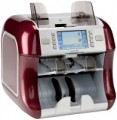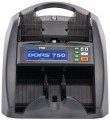Product Type
Type of counting device.
—
Bill counter. Devices designed for simple counting of bills. However, “simple” in this case is a very conditional term, the design may provide various features that significantly simplify the life of the cashier: summation, scanning of serial numbers (see “Functions”), automatic detection of currency type with conversion at a single rate, various types of detection unwanted or counterfeit bills, etc. The only thing that is not supported by such devices is full-fledged sorting: such functionality is the prerogative of specialized equipment (see below). The only could be provided for bill counters, is that the process stops when an error is detected (counterfeit bill, a bills of unwanted currency, etc.).
—
Bill sorter machine. Devices capable of not only counting paper bills, but also sorting them according to one or another parameter — denomination, fitness, etc. For more information about these parameters, see "Bill sorter", here we note that the specific functionality of devices of this type may be different, however, sorting by face is practically mandatory for them, only in single models this function is absent. In addition, bill sorters have at least two receiving pockets. Also note that in addition to this functionality, all the functions of the bill counters described above can be provided.
—
Coin counter. D
...evices used to count large amounts of money in the form of coins. Distinctive features of this technology are capacious loading pockets, where you can put coins in a “heap”, as well as the obligatory presence of sorting by face value (see “Sorting ”). In addition, coin counters provide more accurate sorting than bill counters: even the simplest models have at least 3 receiving pockets, and most often have 6 or more such compartments (up to 10; for more details, see “Number of receiving pockets” ). But special detection in devices of this type is usually absent — modern coins usually do not have such a large denomination that it makes sense to counterfeit them.Max. counting speed
The highest speed that device is able to count bills (coins in the relevant models, see "Product Type"). Higher speed saves time, but it also affects the price and sometimes the size of the device respectively. Its useful to note that using additional functions (for example, sorting by face), as well as in some other cases (such as dilapidated bills), the actual counting speed may slightly decrease compared to the claimed one.
As for specific figures, speeds
up to 1000 bills per minute are considered relatively low, but they are often quite enough in cases where large amounts are recalculated sporadically and high speed rate is not needed. In most counters (of all types), this indicator lies in the range
from 1000 to 2000 bills per minute, and
higher values found only in certain models of coin counters.
Load Tray capacity
The maximum amount of bills or coins that can fit in the pocket (tray) of the counter; in other words — the largest amount of monetary units that can be counted per one run without reloading (and when reloading money, it is worth considering the capacity of the receiving tray — see below)
Note that this parameter is quite approximate — bills can have different thickness, and furthermore, coins are usually arranged randomly. However, it is still undesirable to exceed the recommendations for capacity in order to avoid overloading the gears.
Receive pocket capacity
The largest amount of bills or coins that can fit in the counter's receiving pockets. For models with several receiving pockets (for sorting bills/coins), this paragraph usually indicates the total capacity of these pockets. In some devices, it is allowed to install an additional receiving pocket that expands the capacity; capacity of with such a pocket is indicated separately.
It should be taken into account that anyway this parameter is quite approximate, and the actual capacity may differ slightly from the claimed one: bills, even of the same currency, often have different thicknesses, and coins are scattered randomly in the pocket. Nevertheless, according to the claimed capacity, it is quite possible to evaluate different models of counting machines and compare them with each other.
It is worth noting that the receiving pocket often differs in capacity from the loading tray — sometimes up, sometimes down. This moment depends on the features of operating of the counter. So, if the receiving compartment is larger than the loading one, the device can be additionally loaded with a certain amount of money right during the counting, without any possibility of overflowing the receiver. And in the opposite case, when the counter is fully loaded, you will have to unload the receiver right in the process of operation — otherwise it will overflow before the loading tray is empty.
Number of receiving pockets
The number of receiving pockets provided in the design of the counter; only indicated if there is more than one pocket. In this case, the compartment for rejected bills is not taken into account (for more details, see "Capacity of the pocket of rejected bills").
Pockets in this case are compartments into which the loading tray of the device is divided. They are used for sorting bills/coins according to one or another parameter (see below); accordingly, the number of such compartments can be used to estimate the overall sorting capabilities. So, the simplest option is two pockets, which allows you to separate money according to the principle “match/do not match a certain parameter” (for example, “dollars and other currencies”, “notes with a denomination of less than 100 and more than 100”, etc.). However, it can be
more pockets, that makes it possible to sort by several parameters at once. Such a design is especially relevant for coin counters, where money of several denominations is often loaded at once, and they must be clearly separated; in such machines, the number of receiving pockets can reach 10. Bill sorters have more modest capabilities, they rarely have more than 4 pockets.
Pocket capacity of rejected bills
The capacity of the pocket for rejected bills provided in the design of the counter. To be more precise, only bills sorters have this feature (see "Product Type"): it is not found in regular counters (both bills and coins).
The pocket for rejected money is a separate compartment, which receive discarded bills are received: counterfeit, heavily worn, dirty, etc. This compartment is considered as a separate function and is not counted of total number of receiving pockets (see “Number of receiving pockets). As for its capacity, it is usually rather small compared to the capacity of the loading and receiving pocket: after all, usually rejected bills make up a very small part of the total stack.
Min. bills size
The smallest bills size that the counter can normally process. Specified by length and width, both of these parameters must be at least the minimum allowable value — otherwise the device will not be able to count properly.
Note that most modern currencies use denominations of more or less standard sizes; and with such popular currencies as the dollar or the euro, any counter is almost guaranteed to be compatible. In addition, the manufacturers of counting machines usually take into account the region where they plan to use them, and the dimensions of local money. So you have to pay attention to the allowable sizes of bills mainly in cases where the counter is planned to be used for less common currencies, the size of which may differ markedly from the average.
Max. bills size
The largest bills size that the counter can normally process. It is specified by length and width, both of these parameters must be less than the maximum allowable value — otherwise the device will not be able to handle with the count.
Note that most modern currencies use denominations of more or less standard sizes; and with such popular currencies as the dollar or the euro, any counter is almost guaranteed to be compatible. In addition, the manufacturers of counting machines usually take into account the region where they plan to use them, and the dimensions of local money. So you have to pay attention to the allowable sizes of bills mainly in cases where the counter is planned to be used for less common currencies, the size of which may differ markedly from the average.
Authenticity Check
Types of authenticity check with certain signs on the money being counted and provided in the design of the counter. Only models for paper money are equipped with detection (see “Product Type”).
—
By size. A detection that involves determining the size of a bills. In bill counters, usually, it is used for sorting by face (see "Functions") or dilapidation, but it can also be used for other purposes — for example, identifying bills that are not related to the currency being counted.
—
By optical density. Detection based on optical density — the ability of a bills to transmit and retain light. It is mainly used to detect sticky bills and prevent counting errors, but can also be used to screen out worn or suspicious bills.
—
By magnetic marks. Detection based on the reading of magnetic marks. Typically, such marks are applied with a special paint, "noticeable" for magnetic sensors; note that they are widely used in US dollars and euros. This type of detection can be used both to determine the denomination and to separate bills in other currencies and detect counterfeit bills.
—
Ultraviolet (UV). Detection using UV radiation. Devices with this feature are able to detect special security elements that are visible only under ultraviolet light, and respond to the absence or non-standard arrangement of s
...uch elements. Due to this, it is possible to detect not only counterfeit or foreign bills, but also money marked with special compositions (for example, bills used as material evidence in a criminal case on a bribe and signed respectively). However, if the possibility of identifying marked bills is fundamentally important for you, its availability should be clarified additionally.
— Infrared (IR). Detection using infrared radiation. By the operating principle, it is similar to the UV detection described above, however, protective IR elements are less common, and their detection is technically more difficult. Therefore, this detection function is found mainly in hi-end devices, in particular, high-precision sorters (see "Product Type").
